Made with buckwheat and wheat flours, soba noodles are a beloved staple in Japanese cuisine. They boast a slightly sweet and earthy flavor, paired with a firm texture. You can enjoy these buckwheat noodles year-round, either hot or chilled.
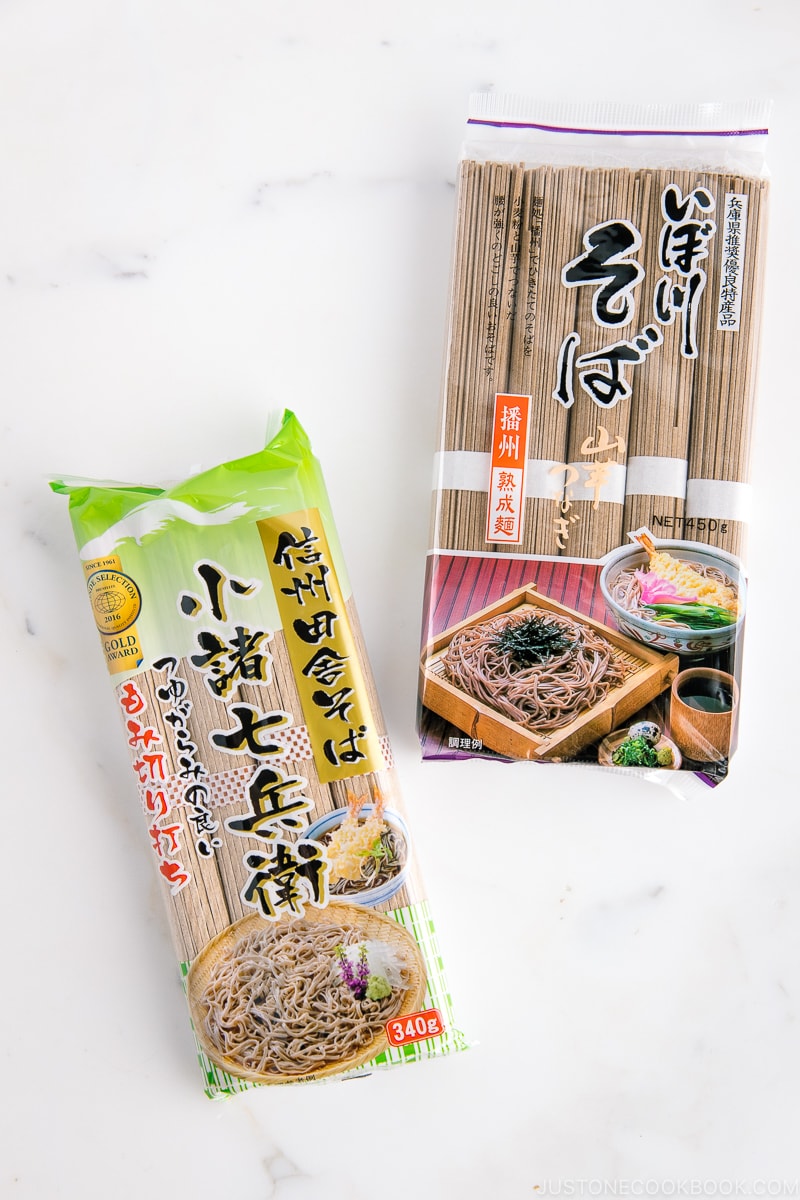
Among the various types of Japanese noodles, soba noodles, also known as buckwheat noodles, offer the most distinct flavor. Their pronounced earthy and complex flavor can veer slightly bitter, but in a good way! Japanese consider soba the healthiest noodles as buckwheat is rich in fiber and a great source of unsaturated fatty acids, vitamins, and minerals.
In this article, we’ll learn more about soba, how to cook the noodles correctly, and some of the best recipes to enjoy soba noodles!
Table of Contents
What Are Soba Noodles
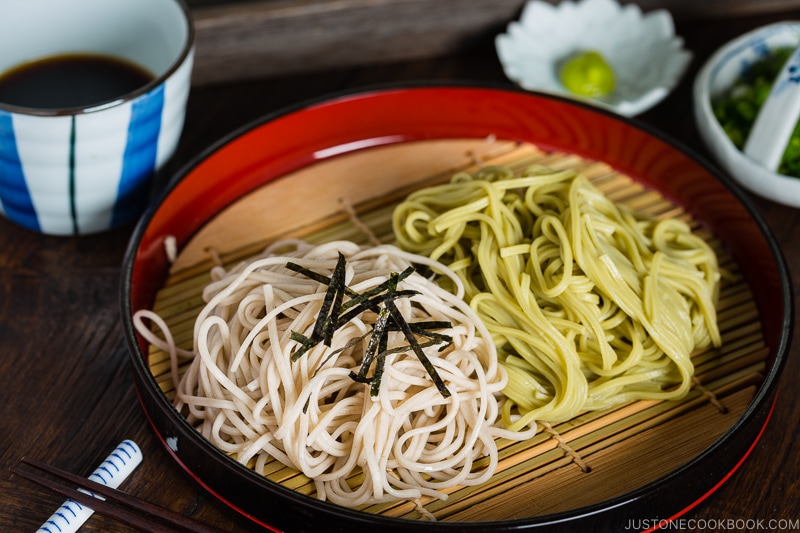
Soba noodles (蕎麦・そば) are thin, long Japanese noodles made from buckwheat flour or a combination of buckwheat and wheat flours, which gives them a characteristic grayish-brown color.
Traditionally, soba is a simple mix of buckwheat and water, but modern-day soba often includes wheat flour as the addition of wheat flour improves its malleability, making it easier to shape into noodles.
Soba making is a specialty in Japan, and soba shops with noodles made in-house are a real treat, as the dough is highly brittle and difficult to knead, thus requiring mastery of the craft. You’ll also find soba variations like matcha, ume plum, and yam, each adding a burst of color, flavor, and aroma to the noodles.
Confusingly, in some cases, “soba” can also refer to noodles not made of buckwheat. Examples include chuka soba (中華そば, “Chinese noodles” – refers to ramen noodles), yakisoba, and Okinawa soba.
What Does It Taste Like
Soba noodles have an earthy and deep nutty flavor from the buckwheat. You’ll notice the difference immediately if you compare the taste to udon, which are wheat flour noodles. A higher percentage of buckwheat results in a more aromatic and nutty flavor, but the noodles are harder and firm.
In Japan, soba noodles are commonly enjoyed chilled with a dipping sauce or in hot dashi broth. When we eat soba, the emphasis is on the taste and flavor of the noodles.
While some non-Japanese interpretations feature loaded bowls with veggies, tofu, and protein or are served as noodle salads, soba is best enjoyed simply with minimal garnishes to allow the flavors to shine through.
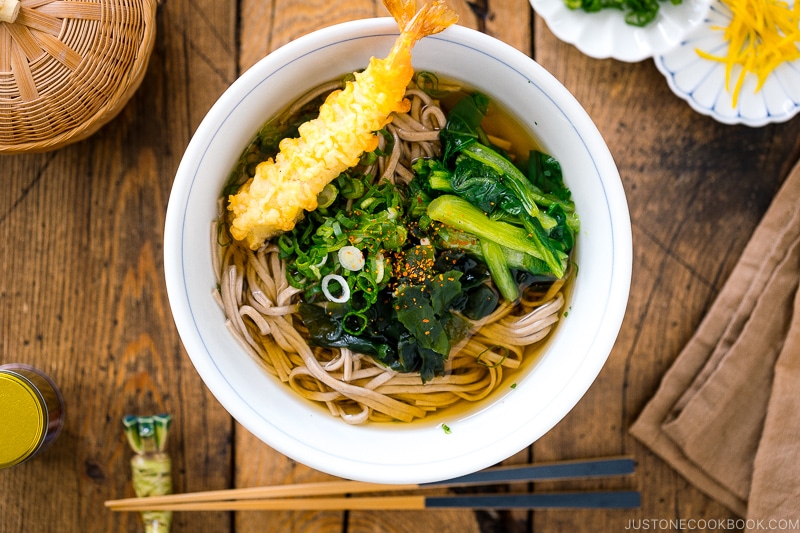
How To Cook Soba Noodles
To cook, bring a large pot of water to a boil over medium-high heat. Unlike pasta, there’s no need for salt. Add the soba to the boiling pot in a circular motion, separating the noodles from each other. Cook the noodles for 4-5 minutes or according to the package instructions (each brand is slightly different). Stir the noodles occasionally to prevent sticking and cook until tender.
Once cooked, quickly drain the noodles and rinse them under cold water to remove the starch and prevent further cooking. Drain the water completely before you serve it cold or hot.
To add flavor to the noodles, serve them with grated ginger, chopped scallions, a dab of wasabi, shredded nori, or shichimi togarashi.
Delicious Soba Noodles Recipes
Here are some of the most authentic and classic ways to enjoy soba noodles:
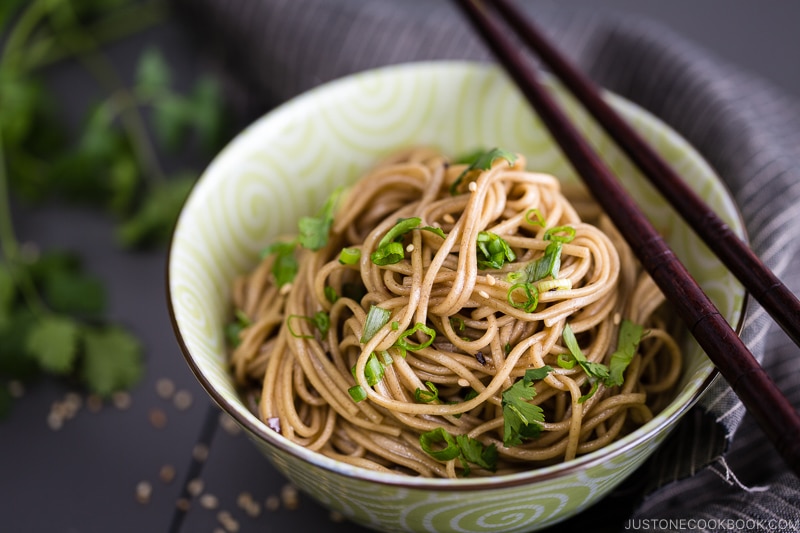
🥢 Soba Noodles Salad – For a quick, light meal, this Soba Noodle Salad tossed in a honey-soy dressing is exactly what you need. Enjoyed chilled or at room temperature.

🥢 Soba Noodle Soup – This simple steamy bowl of soba noodle is topped with fresh greens, store-bought tempura, and sliced scallion. My recipe also shows you 8 popular toppings you can use to top your noodle soup.

🥢 Zaru Soba (Cold Soba Noodles) – This cannot-be-any-easier chilled noodle dish is the most classic way to enjoy soba noodle, especially on hot summer days. We often serve it with a platter of fresh cooked tempura, but you can just use store-bought ones.

🥢 Toshikoshi Soba (New Year’s Eve Soba Noodle Soup) – Did you know the tradition of eating soba noodles on New Year’s Eve started as early as the 13th or 14th century in Japan? Like the tough buckwheat crop, the thin, long soba represents longevity, strength, and resilience. The dish is usually served in its simplest form, in a hot dashi broth with finely chopped green onion. I hope you too will join us in adopting this custom in ushering the new year!
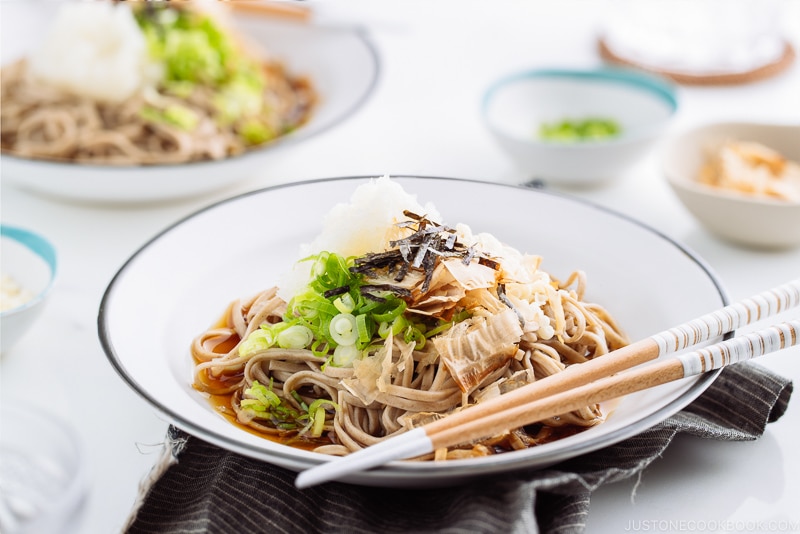
🥢 Oroshi Soba – Literally means “grated daikon buckwheat noodles,” this is one of the popular soba noodle menus that you can find at noodle shops in Japan. The signature of this dish is the grated daikon on top of the noodles.
Where to Buy
In the US, you can find soba noodles in Asian and Japanese grocery stores, as well as major grocery stores such as Whole Foods or local co-ops. Online Asian grocers or Amazon carry a variety of soba noodles too.
Soba noodles are commonly sold dried. A typical package comes with 3 to 6 bundles of noodles. You can also find fresh or frozen soba in the refrigerated or frozen sections at Japanese or Asian grocery stores.
Recommended Brands for Soba Noodles
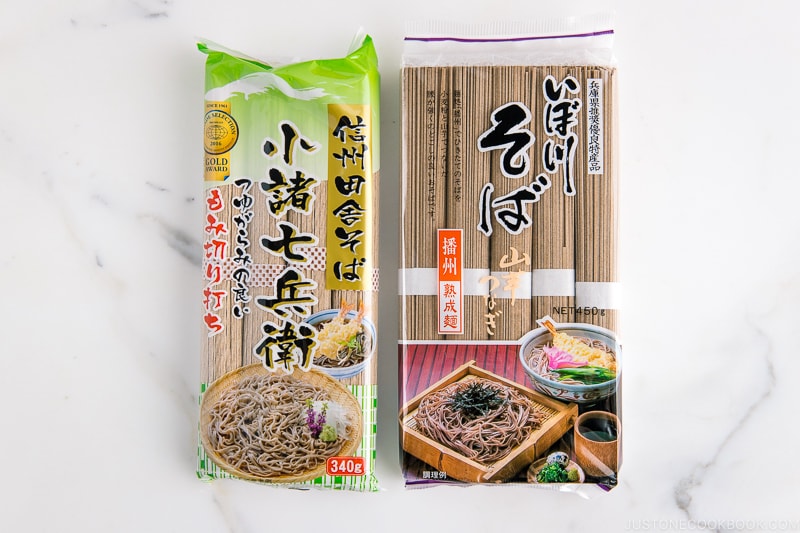
To be honest, soba brands are pretty limited here in the U.S. or outside of Japan in general. The best brand for soba noodles that I discovered are Shinshu Inaka Soba – Komoro Shichibei (信州田舎そば 小諸七兵衛) by Hoshino Bussan (星野物産). Shinshu Inaka Soba has a remarkable good bite that stands out immediately. I get them from my local Japanese grocery store Nijiya Market.
Some other common brands include Hakubaku Organic Soba, Hime Soba Noodles, or Eden Foods Soba (this is 100% buckwheat; gluten-free).
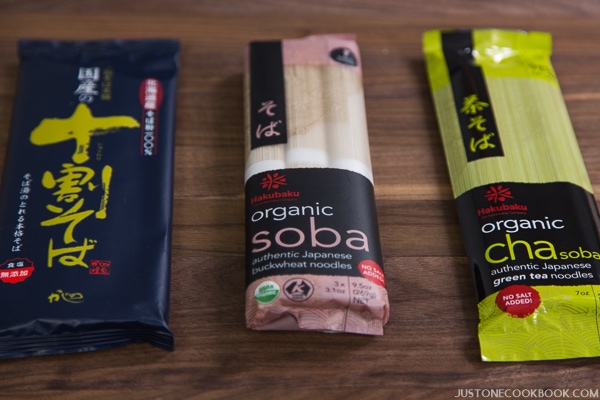
How To Choose The Best
If you are looking for noodles from Japan, find the word そば on the package. If you want to try the real deal, try juwari-soba made of 100% buckwheat flour.
Varieties Of Soba
There are two main varieties of soba: styles and the ratio of buckwheat. Here are some names you may encounter.
Styles
- Sarashina soba (更科蕎麦): Made with refined buckwheat flour, the noodles are off-white and cut into thin strands.
- Yabu soba (藪蕎麦): Originating from Toshima-ku (northwestern Tokyo), these noodles have a slightly green hue from the buckwheat skin.
- Inaka soba (田舎蕎麦): Dark in color, with a strong buckwheat flavor and thick. It’s made from unhulled buckwheat seeds ground into coarse flour.
Ratio of buckwheat
- 100% buckwheat: Juwari soba (十割蕎麦) is extremely hard and chewy but highly aromatic. It has a dry and rough texture, causing the noodles to break easily. It has a strong buckwheat aroma and flavor, but it is difficult to make due to its crumbly texture.
- 80% buckwheat and 20% wheat: Hachiwari soba (八割そば) is the most basic and well-balanced.
- 20% buckwheat and 80% wheat: Niwari soba (二割蕎麦) is the smoothest noodles with a slight hint of buckwheat. It tends to be the most affordable.
How To Store
Store dried packages in a low-humidity, cool, dark place like other dried noodles. Once you open the package, make sure to seal it properly.
Fresh soba will last 1-2 weeks, but check the expiration date and use up quickly.
For cooked noodles, you can store leftovers in the freezer or fridge. Consume within two days.
Origin Of Soba
Soba supposedly originated in China and was brought to Japan toward the end of the Jomon period (10,000 to 300 BC). While there are several theories regarding the origin of soba, it was initially eaten as boiled dumplings called soba-gaki (蕎麦がき). You can still find soba-gaki on the menus of some soba restaurants.
It wasn’t until the Edo period (1603-1867) that soba became the thin, long noodles we know today. Soba was a popular street food that could be prepared and eaten quickly.
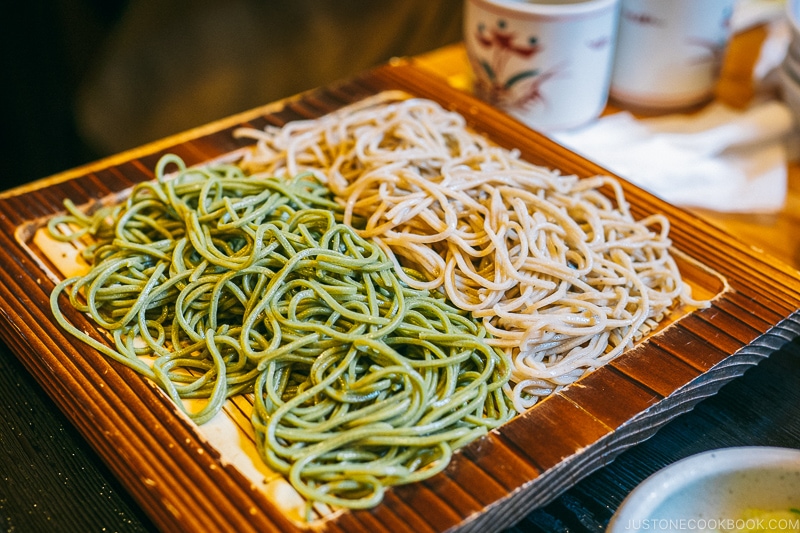
Famous Regional Soba – Nagano Prefecture
Regions particularly well-known for its premium soba is Nagano Prefecture. It’s an area where 80% of the land is mountainous, providing a pristine environment for growing buckwheat but not rice. Surrounded by highlands with volcanic ash soil and fresh, clean water, Nagano also boasts distinctive temperatures well-suited for soba production.
Togakushi (戸隠) and Kurohime (黒姫) are just two of the more famous soba production centers located in the prefecture. You can even find local shops and facilities offering soba-uchi (蕎麦打ち, making soba by hand).
Interested in learning more about soba making? Visit Togakushi Soba Museum in Nagano prefecture.
Health Benefits of Soba Noodles
In Japan, soba is considered a health food. Even though it is still not as trendy and well-known as ramen in the U.S., many recognize the unique flavor of soba as a healthy alternative to wheat-based noodles.
Buckwheat flour is not a wheat but an ancient grain that is a good source of nutrients like protein, fiber, iron, carbohydrates, thiamine, and manganese. Soba contains fewer calories, fiber, and protein than spaghetti and other pasta, so that it won’t spike your blood sugar levels. For those who prefer a low-carb diet, soba is an excellent choice as it is low in fat and calories.
Soba is a delicious alternative for those unable to consume wheat. Make sure to check the ingredient list before purchasing.
FAQs
Q: What’s the difference between soba and udon noodles?
One significant difference is its ingredients. Soba is made of buckwheat and sometimes wheat flour and a binder, whereas udon is made with wheat only. Read more about the difference between soba and udon noodles here.
Wish to learn more about Japanese cooking? Sign up for our free newsletter to receive cooking tips & recipe updates! And stay in touch with me on Facebook, Pinterest, YouTube, and Instagram.



